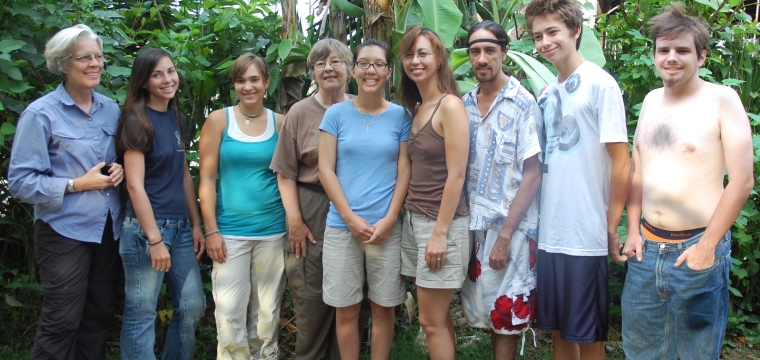Thank you for your interest in the El Pilar Program! This unique program has been ongoing since 1993, and in operation in Belize since 1982. If you are interested in joining the El Pilar team, we suggest that you contact us as soon as possible. Our living space is limited and can fill up quickly.
After reading the following, if you have any questions please feel free to contact Dr. Ford via phone 1-805-893-8191 or e-mail ford@marc.ucsb.edu.
Location
The El Pilar Archaeological Reserve for Maya Flora and Fauna is located just 12 miles (approximately 19 kilometers) north of the western Belizean town of San Ignacio, astride the Belize-Guatemala border. The ridge land escarpment where El Pilar is situated extends from Guatemala's Petén into Belize, north of the Belize River valley. San Ignacio is the largest town in Western Belize (population approx. 19,000) and lies in a lush river valley 70 miles from Belize City. The town offers mail and banking services, it has restaurants, hotels, and resorts; and there are grocery stores, travel agencies, shopping facilities, including a Saturday farmers market.
Accommodations
The Program is headquartered in the Santa Elena area, located about 1 km. south of the center of San Ignacio. We stay in a rented housing with shared rooms and bathrooms.
The Program has long enjoyed the fantastic produce of the weekly market. Cooking and cleaning responsibilities are shared between team members. Sunday meals are on your own and many enjoy sampling the many small restaurants in the area or prepare their own meals in the BRASS base kitchen.
Qualifications
The Program takes volunteers and students. You should be at least 18 years of age and in good physical shape. Passion for the projects’ multiple facets is imperative: the Maya past and present, the archaeology of the tropics, community development, and Maya forest gardening, among others. Experience is preferred, but not required. Conversational knowledge of Spanish is helpful. We are particularly interested in graduate students looking for advanced projects in a number of areas: archaeology, ecology, plant and wildlife biology, history, geology, agriculture, and community development. Participation can be arranged for as little as two weeks or as long as the entire field season. Participants interested in the entire field season take precedent.
Costs
The cost for the entire field season is US $2500. This covers room, board, and activities related to our research agenda for the season. Participants are responsible for their own travel to and from Belize. The cost of the program may be made as a tax-deductible donation through the University or our non-profit organization Exploring Solutions Past~The Maya Forest Alliance.
The cost for short term participants (up to three weeks) is US $2000 and covers room, board, and site transportation. Longer stays are subject to a charge per week - contact our office for further information. The tax-deductible donation helps the program to pay some of the overhead costs associated with a large multidisciplinary program.
Field Season
The El Pilar field season focuses on the development of the El Pilar site and community activities that link archaeology with local Maya forest gardeners and the surrounding community at large. Field work will include site visits, study of traditional Maya farmers’ lands, work in the school garden, and studies, surveys, and mapping at El Pilar. The core of fieldwork takes place from May to June annually.
Our work will consider the following aspects of the Maya forest:
- Mapping Maya house sites at El Pilar
- Urban El Pilar: high density and complex distribution of structures
- Rural El Pilar: low density and simple distribution of structures
- Traditional farmer input: understanding the land use potentials
- Floristic complexity of today: vegetation levels and the height of the canopy
- In the fields and orchards: multicroping, agroforestry, forest regeneration
- Traditional land management: soil maintenance, land cover, pest management
- Food chain of the forest garden: faunal distribution
- Maize is the canopy of the open sun stage: small mammals, reptiles, birds, insects
- Forest as canopy: browsers, small mammals, reptiles, birds, insects, plus arboreal fauna, top predators
- Spacing: unique material and spatial distribution necessary for the subsistence, nesting, and reproduction of rainforest species
- Management: domestication, hunting, pets, pests, ritual use
Direction and Leadership
The Director of the El Pilar Program is Dr. Anabel Ford of the MesoAmerican Research Center at the University of California Santa Barbara. Dr. Ford has researched and published on the ancient Maya, the management of the ancient monuments, and the importance of traditional farmers in the conservation of the Maya forest. Her fieldwork focuses on the Maya forest of Guatemala and Belize, with some work in the U.S. and Peru.
In the field Anabel joins with local collaborators Andres Romero, Norberta Pulido, and Narciso Torres who work with us at our local headquarters, BRASS Base Camp.
For more information on the project contact Dr. Anabel Ford at:
ISBER/MesoAmerican Research Center University of California Santa Barbara, CA 93106 USA ford@marc.ucsb.edu.
Application
If you have a serious interest in the program then your next correspondence with the program should include;
1) A filled-out application
2) Completed BRASS Medical form and BRASS Acknowledgment and Consent form
3) A brief resume or C.V.
Your application will be considered by the program staff and we will be in contact with you. When you are accepted by the El Pilar Program, a further information package will be sent to you. Completed applications should be sent to our California office at the address below.
Dr. Anabel Ford ISBER/MesoAmerican Research Center University of California Santa Barbara, CA 93106 USA

